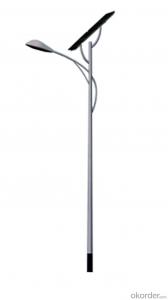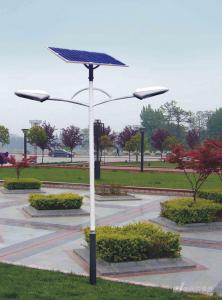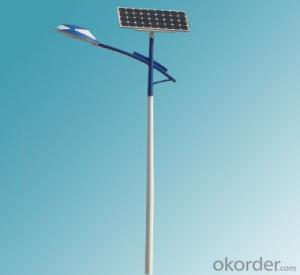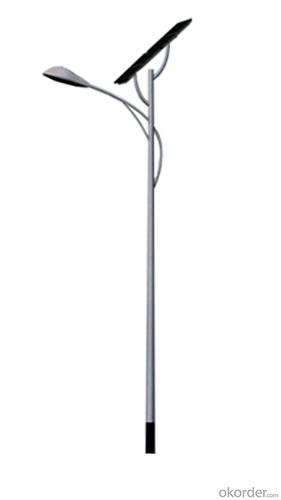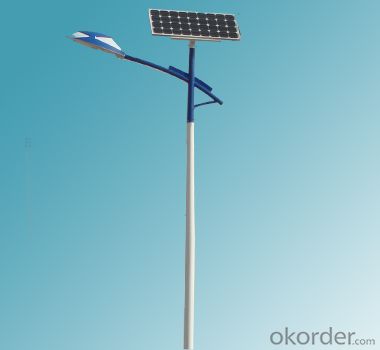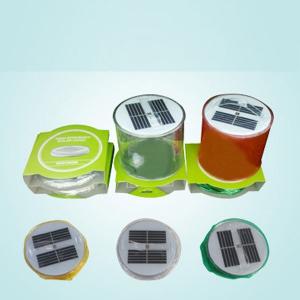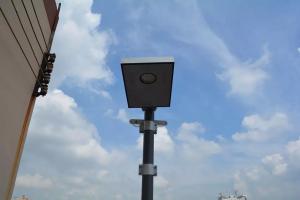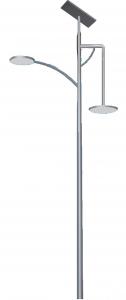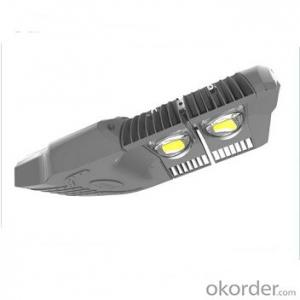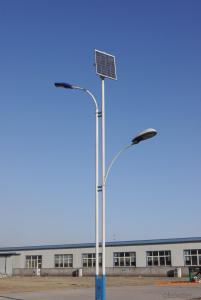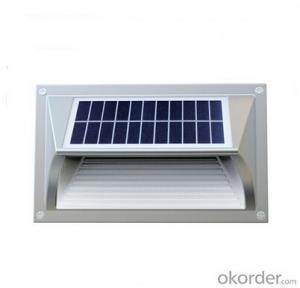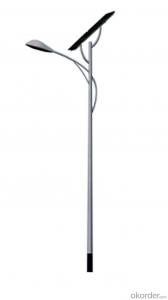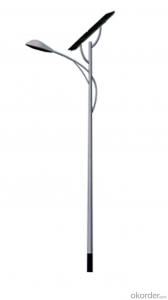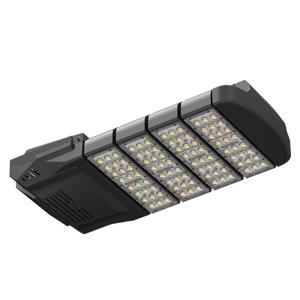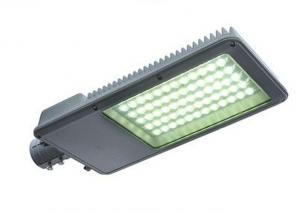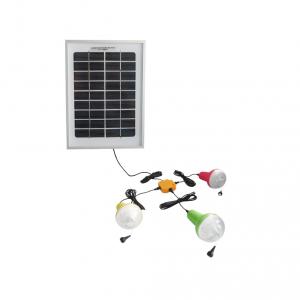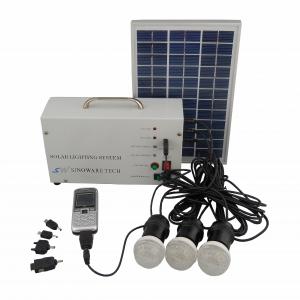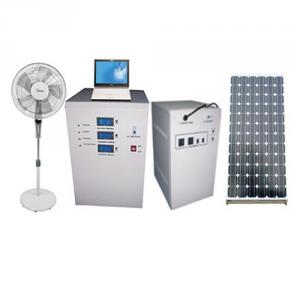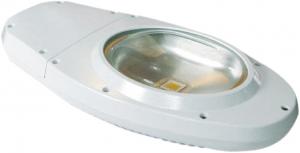Firefly Solar Light - New Energy Solar Street Light Q709
- Loading Port:
- Ningbo
- Payment Terms:
- TT or LC
- Min Order Qty:
- 1 set
- Supply Capability:
- 5000 set/month
OKorder Service Pledge
OKorder Financial Service
You Might Also Like
1, Product desciption
Inverter circuits designed to produce a variable output voltage range are often used within motor speed controllers.
The DC power for the inverter section can be derived from a normal AC wall outlet or some other source. Control and feedback circuitry is used to adjust the final output of the inverter section which will ultimately determine the speed of the motor operating under its mechanical load.
Motor speed control needs are numerous and include things like: industrial motor driven equipment, electric vehicles, rail transport systems, and power tools. (See related: variable-frequency drive ) Switching states are developed for positive, negative and zero voltages as per the patterns given in the switching Table.
The generated gate pulses are given to each switch in accordance with the developed pattern and thus the output is obtained.
Solar power is energy from the sun. "Solar" is the Latin word for "sun" and
And Powerful source of energy. Without it, there will be no life.
Solar energy is considered as a serious source of energy for many years
of the vast amounts of energy that is made freely available, if harnessed by modern technology.
A magnifying glass can be used to heat up a small amount of water.
The short piece of copper tube is sealed at one end and filled with water.
And magnifying glass is then used to warm up the pipe.
Using more than one magnifying glass will increase the temperature more rapidly.
2, Features of the product
Inverters convert low frequency main AC power to higher frequency for use in induction heating.
To do this, AC power is first rectified to provide DC power. The inverter then changes the DC power to high frequency AC power. Due to the reduction in the number of DC Sources employed, the structure becomes more reliable and the output voltage has higher resolution due to an increase in the number of steps so that the reference sinusoidal voltage can be better achieved.
This configuration has recently become very popular in AC power supply and adjustable speed drive applications. This new inverter can avoid extra clamping diodes or voltage balancing capacitors. There are three kinds of level shifted modulation techniques, namely:
The first thing to figure out is the length of road in need of street lights.
This can be a small entrance road only a couple hundred of feet long to miles of streets through an area. Does the area currently have any type of lighting available.
What is the reason for needing street lights in this area
Is the electrical grid already nearby or would you need to call in the power company to bring in electrical lines.
If the electric needs to be brought to the area, how much is this going to cost? Depending on how far the grid electric is from the location of the needed lighting, this can be quite expensive.
How much lighting is needed on the street? Do the lights need to be dark sky compliant.
Do the street lights need to run from dusk to dawn or for only a specified number of hours at night.
Are the street lights able to dim in the middle of the night and still provide enough lighting.
These questions need to be answered before you can decide on how many lights you will need to complete the project.
3, Detailed Specification
| ||||||||||||||||||||||||||||||||||||||||||||||||
4, Product Image
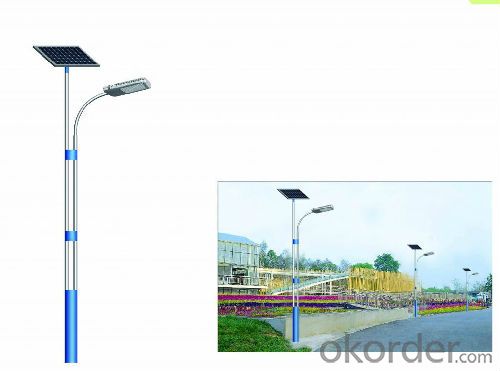
- Q: Are solar lights suitable for roadside emergencies or breakdowns?
- Yes, solar lights are suitable for roadside emergencies or breakdowns. They are portable, easy to set up, and do not rely on electricity or batteries. Solar lights can provide bright and reliable illumination, ensuring safety and visibility during such situations.
- Q: Are solar lights resistant to fire hazards?
- Solar lights, in general, are resistant to fire hazards. Unlike traditional lights that rely on electricity and wiring, solar lights function by utilizing sunlight and do not present the same fire dangers. These lights employ small photovoltaic panels that convert sunlight into electricity, which is then stored in rechargeable batteries. Since there is no direct connection to a power source or electrical wiring, the likelihood of electrical fires is significantly diminished. Moreover, most solar lights are designed with safety features built-in, such as overcharge and over-discharge protection, further minimizing fire hazards. However, it is worth noting that although solar lights themselves are fire-resistant, any flammable materials in their vicinity or improper installation could still potentially create risks.
- Q: Can solar lights be used for outdoor sculptures or artwork?
- Yes, solar lights can be used for outdoor sculptures or artwork. They provide a sustainable and energy-efficient lighting solution that can enhance the aesthetics of the artwork while also highlighting its beauty during nighttime. Additionally, solar lights are easy to install and do not require extensive wiring, making them a convenient choice for illuminating outdoor sculptures or artwork.
- Q: Can solar lights be used for art installations?
- Yes, solar lights can definitely be used for art installations. They offer a sustainable and energy-efficient option for illuminating artworks, sculptures, or outdoor installations. Solar lights can be easily installed without the need for complex wiring or electrical connections, making them a popular choice for outdoor and temporary art displays. Additionally, they can be programmed to create various lighting effects, enhancing the artistic appeal of the installation.
- Q: Can solar lights be used to light up a large area?
- A large area can indeed be illuminated using solar lights. However, the extent to which solar lights can effectively light up a given area depends on several factors, including the brightness of the lights, the number of lights utilized, and the quality of the solar panels and batteries. Solar lights are designed to capture energy from the sun and convert it into electricity for powering the lights. As long as there is an adequate amount of sunlight during the day, the batteries will be charged by the solar panels, enabling the lights to function at night. To illuminate a large area, it is crucial to select solar lights with higher levels of brightness and consider the strategic placement of multiple lights throughout the area. Furthermore, opting for solar lights with larger solar panels and batteries of higher capacity will ensure that enough energy is stored to illuminate the area for a longer duration. It is worth noting that solar lights may not be as powerful as conventional electric lights, meaning that they might not provide the same level of brightness. However, advancements in solar technology have resulted in the development of more efficient and brighter solar lights, rendering them a feasible choice for illuminating larger areas. Ultimately, the effectiveness of solar lights in illuminating a large area hinges on the specific requirements of the area, the quality of the solar lights, and the availability of sunlight.
- Q: Can solar lights be used for outdoor wedding ceremonies and receptions?
- Yes, solar lights can be used for outdoor wedding ceremonies and receptions. They provide a charming and eco-friendly lighting option that can enhance the ambiance and aesthetic of the event. Additionally, solar lights are easy to install and operate, making them a convenient choice for outdoor settings.
- Q: Can solar lights be used in remote areas?
- Certainly, solar lights are a viable option for use in remote areas. In fact, they are particularly well-suited for such regions where access to electricity is limited or non-existent. Solar lights function by harnessing the sun's energy to charge their batteries during the day, enabling them to emit light at night. This adaptability makes them an excellent choice for areas that lack connections to the electrical grid. One of the primary advantages of utilizing solar lights in remote areas is their independence from conventional power sources. Consequently, individuals residing in these regions can enjoy lighting without the need for costly infrastructure or ongoing electricity expenses. Additionally, solar lights are straightforward to install and require minimal upkeep, making them a practical and cost-effective solution for remote areas. Furthermore, solar lights can greatly enhance safety and security in remote areas. They can be employed to illuminate streets, pathways, and public spaces, thereby facilitating safer nighttime navigation. Furthermore, solar lights can be utilized in homes, schools, and health clinics in remote areas, ensuring that basic lighting needs are met and enhancing the overall quality of life for residents. Moreover, solar lights are environmentally friendly, emitting no harmful emissions and relying solely on renewable energy sources. By utilizing the abundant sunlight available in remote areas, they contribute to reducing carbon footprints and preserving the natural environment. In summary, solar lights are a pragmatic, cost-effective, and sustainable solution for lighting in remote areas. They provide access to lighting in regions where traditional electricity is unavailable and contribute to improved safety, security, and quality of life for individuals residing in these areas.
- Q: Can solar lights be used in urban areas with limited sunlight?
- Yes, solar lights can be used in urban areas with limited sunlight. While the efficiency of solar lights may be affected by reduced sunlight, advancements in solar technology have made it possible to capture and store energy even in low light conditions. Additionally, modern solar lights often come with efficient batteries that can provide backup power during periods of limited sunlight, ensuring continuous illumination.
- Q: How do solar lights handle snow or ice?
- Solar lights are designed to withstand various weather conditions, including snow and ice. Most solar lights have a durable and weather-resistant casing that protects the internal components from water and other elements. Additionally, the solar panels are typically made with tempered glass, which is highly resistant to damage from snow and ice. During snowy or icy conditions, the solar lights may become covered with a layer of snow or ice, which can reduce their efficiency. However, most solar lights are designed with a tilted solar panel or a smooth surface, which helps to minimize snow or ice buildup. Additionally, the heat generated by the solar panels can help melt the snow or ice, allowing the lights to continue functioning effectively. It is worth noting that extreme snowfall or ice accumulation might still hinder the performance of solar lights. In such cases, it may be necessary to manually clear the snow or ice from the lights to ensure optimal charging and illumination. However, it is important to exercise caution when removing snow or ice to avoid damaging the lights or their components. Overall, solar lights are designed to handle snow and ice, and with proper maintenance, they can continue to provide reliable lighting even during winter conditions.
- Q: Can solar lights be used for pathway and stair lighting?
- Yes, solar lights can be used for pathway and stair lighting. Solar lights are designed to harness the power of the sun to generate electricity, which is then stored in rechargeable batteries. They do not require any electrical wiring, making them a convenient and cost-effective option for outdoor lighting. Solar pathway lights are often equipped with stakes or posts, allowing them to be easily placed along pathways or driveways. They are designed to emit a soft and ambient light, making them perfect for illuminating walkways and stairs at night. Additionally, some solar lights come with motion sensors, automatically turning on when someone approaches, providing added safety and security. Overall, solar lights are a great choice for pathway and stair lighting as they are eco-friendly, easy to install, and require minimal maintenance.
Send your message to us
Firefly Solar Light - New Energy Solar Street Light Q709
- Loading Port:
- Ningbo
- Payment Terms:
- TT or LC
- Min Order Qty:
- 1 set
- Supply Capability:
- 5000 set/month
OKorder Service Pledge
OKorder Financial Service
Similar products
Hot products
Hot Searches
Related keywords
